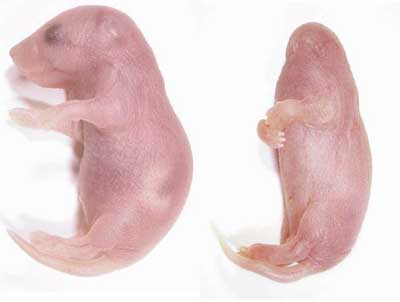| RIKEN Center for Developmental Biology
(CDB) 2-2-3 Minatojima minamimachi, Chuo-ku, Kobe 650-0047, Japan |
Now, in a research article published in the June issue of the journal Development, members of the Laboratory for Embryonic Induction (Hiroshi Sasaki; Team Leader) report new insights into the function of the transcriptional co-activator protein Ssdp1 in the later stages of head organizer development. The study, led by Noriyuki Nishioka, a research scientist in the Sasaki lab, in collaboration with labs in the Universities of Osaka, Hokkaido, Minnesota and Texas and the NIH casts the genetic regulation of head induction in a fresh light by revealing one more component of the complex interplay between transcription factors needed to establish the structures of the head at the appropriate sites and developmental stages.
The story began with a single mouse mutant, in which the embryo failed to develop any head structures whatsoever anterior to the ear, a hallmark of disturbed head organizer function. The mutation was discovered fortuitously during a transgenesis experiment involving an entirely different gene, which led the Sasaki team to surmise that they’d serendipitously interfered with a gene involved in head organizer formation or its activity and, dubbing this striking phenotype headshrinker (hsk), they set off working at once to identify the gene in question. The results of fluorescence in situ hybridization (FISH), a method for tagging and mapping genetic genes to their chromosomal locations, showed that their target was a gene on chromosome 4 named Ssdp1 (for single-stranded DNA binding protein). The headshrinker phenotype results when Ssdp1 expression is downregulated and they found that they were able to rescue this phenotype by creating mice transgenic for Ssdp1, in which head organizer was apparently restored as pups were born with heads intact. Nishioka et al next looked at head organizer development in the hsk mutants in closer detail and found that although early head organizer tissuessuch as the anterior visceral endoderm and anterior definitive endoderm formed appropriately, at day E7.5 the prechordal plate failed to take shape. When they next studied the effects of this prechordal plate defect on the neural ectoderm, they observed that all ectoderm-derived head structures anterior to the midbrain-hindbrain boundary were absent, suggesting that the prechordal plate works to suppress posteriorization of the neural ectoderm, a function important to the induction and maintenance of normal head development. Previous studies had shown that another transcription factor, Lim1, is also essential for head organizer function, as indicated by the headless phenotype of Lim1 mutant mice. The Lim1 protein is a member of the LIM homeodomain family of transcription factors, and relies on its co-factor, Ldb1, which, interestingly, is also known to interact with Ssdp1. Intrigued by this connection, Nishioka hypothesized that Ssdp1 forms a ternary complex with Lim1-Ldb1, enhancing its transcriptional activator function. The team showed that all three of these factors are expressed in prechordal plate mesenchyme, and that simultaneous co-expression of Ssdp1, Lim1 and Ldb1 in vitro caused the marked upregulation of a prechordal plate-specific reporter gene. Indeed, even Ssdp1 alone caused dose-dependent transcriptional activation when expressed in the presence of Ldb1. This series of experiments strongly points to a model in which a tripartite Ssdp1-Lim1-Ldb1 complex regulates head morphogenesis by driving the expression of genes in the late-stage head organizer, the prechordal plate. But the story doesn’t end there as, in addition to its headlessness, the hsk mutant also exhibits a range of general defects in cell survival and proliferation and thoracic development, leaving questions of Ssdp1 function in those phenomena open to further study.
|
||||
|
||||
[ Contact ] Douglas Sipp : sipp@cdb.riken.jp TEL : +81-78-306-3043 RIKEN CDB, Office for Science Communications and International Affairs |
| Copyright (C) CENTER FOR DEVELOPMENTAL BIOLOGY All rights reserved. |
